Videos play a crucial role in various domains, such as machine learning (ML), computer vision, healthcare, and entertainment, so accurate and efficient video data annotation has become more vital. Video annotation involves labeling and marking specific objects, actions, or events within a video to facilitate analysis, training of algorithms, or enhancing user experience.
If you are a researcher, developer, or enthusiast diving into video analysis, this guide will take you through the fundamentals, techniques, and best practices of video annotation. Let’s analyze the complexities of annotating videos effectively and release the full potential of visual data interpretation.
Get things started!
What is video annotation?
In a nutshell, video annotation is the process of carefully labeling, categorizing, or adding metadata to video content to make it more understandable, searchable, and useful for various applications. It involves identifying and tagging specific elements within a video, such as objects, actions, events, or emotions, to provide context and meaning to the visual information.
This complex task is typically undertaken by human annotators who thoroughly analyze each video frame, often aided by specialized software tools. Annotations can take various forms, such as outlines of different elements within a frame or temporal annotations marking the duration of certain events.
According to the Verified Market Reports, the video annotation service market is expected to grow significantly from 2023 to 2030, driven by increased demand across various industries (agriculture, retail, and others). The report provides detailed insights into market trends, segments, regions, and significant players. It includes quantitative and qualitative data analysis, considering product pricing, market dynamics, consumer behavior, and economic scenarios.
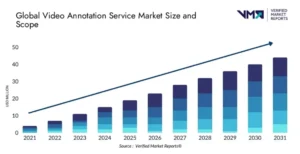
Fundamental types of video data annotation
In general, video data annotation involves labeling or marking objects, actions, or events within video footage to train machine learning models. Here are some common types of video data annotation:
Bounding boxes
Video annotation concerns marking bounding boxes around objects of interest within video frames. This is used to identify and track specific objects or entities.
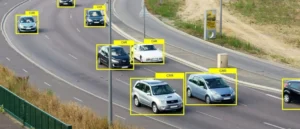
Instance segmentation
This is about annotating each pixel within a video frame to outline different objects. Unlike bounding boxes, instance segmentation provides a more precise outline of object boundaries.
Semantic segmentation
Annotation involves labeling each pixel in a video frame with a class label, indicating the type of object or scene it belongs to. This is useful for tasks like scene understanding or background separation.
Activity recognition
Video annotations concern labeling actions or activities performed by objects or individuals within video sequences. This could include actions like walking, running, sitting, or more complex activities.
Temporal annotation
This is about marking specific timestamps or time intervals within a video to indicate the occurrence of events, changes, or transitions. Temporal annotations are crucial for tasks like event detection or activity timing.
Pose estimation
Video annotation involves labeling key points or joints on human subjects within video frames to track and analyze body movements or poses. This is often used in sports analysis, fitness tracking, or gesture recognition applications.
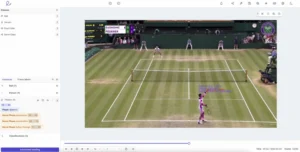
Emotion recognition
Annotation concerns labeling facial expressions or body language within video frames to understand the emotional state of individuals. This is used in applications like affective computing or sentiment analysis.
Text annotation
This is about identifying and transcribing text within video frames, such as subtitles, captions, or on-screen text. This is useful for tasks like video indexing, translation, or accessibility.
3D annotation
Video annotation involves labeling objects or events in 3D space within video sequences. This is used in autonomous driving, augmented reality (AR), or robotics applications.
Depth annotation
This is about estimating the depth or distance of objects within video frames. This is important for tasks like scene reconstruction, depth perception, or virtual reality.
These video data annotation types can be used individually or in combination depending on the specific requirements of the video analysis task.
Despite its significance, video annotation can be laborious and time-consuming, requiring skilled annotators and sophisticated tools. However, the benefits it offers in terms of enhanced understanding, automation, and innovation across various domains make it an essential technique. Let’s check these advantages together.
Main benefits of video annotation
Video annotation, the process of labeling or tagging video content with relevant metadata, has become increasingly important in various fields such as computer vision, machine learning, robotics, and more. The advantages of video data annotation are multifaceted and contribute significantly to advancing technology and various applications. Below are several fundamental benefits of video data annotation:
- Training machine learning models: Video data annotation plays a crucial role in training machine learning models, especially computer vision-related ones. By labeling objects, actions, scenes, and other relevant information within videos, annotation provides the ground truth data necessary for supervised learning algorithms to understand and recognize patterns. This facilitates the development of accurate and robust models for object detection, activity recognition, and video classification tasks.
- Improving model accuracy: In fact, accurate annotation of video data helps improve the accuracy of machine learning models. By providing precise labels and annotations, data annotators enable models to learn from high-quality training data, leading to better performance and reduced errors. Consistent and detailed annotations also help prevent biases and ensure that models generalize well to new data.
- Enhancing object detection and tracking: Video data annotation enables models to be trained for object detection and tracking tasks. By annotating objects of interest within video frames with bounding boxes or segmentation masks, annotators provide the necessary information for algorithms to identify and track objects over time. This is essential for administration, autonomous vehicles, and human-computer interaction applications.
- Supporting semantic understanding: Semantic understanding of video content (recognizing actions, events, and object relationships) relies on accurate annotation. Annotated video data allows models to infer semantic information from visual cues, enabling applications such as video summarization, content recommendation, and video search. Semantic annotations also aid in generating illustrative captions or subtitles for accessibility purposes.
- Enabling autonomous systems: Video data annotation is necessary to develop autonomous systems, including robots and drones. By annotating videos with information about the environment, obstacles, and navigation paths, annotators assist in training models for perception, planning, and decision-making. This facilitates the deployment of autonomous systems in various domains, such as agriculture, logistics, and exploration.
- Facilitating behavioral analysis: Video data annotation supports behavioral analysis and understanding in psychology, sociology, and human-computer interaction fields. By labeling human actions, gestures, and expressions within videos, annotators enable researchers to study social interactions, cognitive processes, and user behavior. This can lead to insights that inform the design of products, services, and interventions.
- Driving innovation in entertainment and media: In the entertainment and media industry, video data annotation fuels innovation by enabling the creation of immersive experiences, personalized content, and interactive storytelling. By annotating video content with metadata such as scene descriptions, character identities, and emotional cues, annotators boost content discovery, recommendation, and adaptation across platforms and devices.
- Supporting medical diagnosis and treatment: In healthcare, video data annotation aids in medical imaging analysis, surgical training, and patient monitoring. By annotating medical videos with annotations such as anatomical structures, abnormalities, and procedural steps, annotators support diagnostic decision-making, surgical skill assessment, and treatment planning. This contributes to improved patient outcomes and medical education.
In general, by providing labeled video data, annotators enable the development of advanced technologies, facilitate research and innovation, and ultimately improve our understanding of the world.
Common industries using video annotations
Video annotation finds applications across various industries due to its ability to extract valuable insights and support tasks such as object detection, behavior analysis, and semantic understanding. Let’s explore how video annotation is utilized in the different sectors:
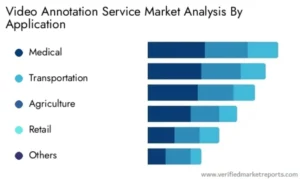
Medical industry
Video annotation is crucial in medical imaging analysis, surgical training, and patient monitoring. In medical imaging, videos from modalities like MRI (magnetic resonance imaging), CT (computed tomography) scans, and endoscopy are annotated to identify anatomical structures, abnormalities, and disease markers. Moreover, video annotations assist radiologists and clinicians in diagnosing conditions such as tumors, fractures, and cardiovascular diseases more accurately.
In surgical training, videos of procedures are annotated to highlight critical anatomical landmarks, surgical steps, and best practices. Video annotations aid in teaching medical students and assisting surgeons in skill assessment and performance improvement. Additionally, video annotation supports patient monitoring by tracking vital signs, movement patterns, and physiological changes over time, enabling early detection of health issues and personalized treatment plans.
Transportation industry
Video annotation is essential for developing autonomous vehicles, traffic monitoring systems, and transportation infrastructure planning. In autonomous vehicles, videos captured by cameras mounted on vehicles are annotated to detect and classify objects such as vehicles, pedestrians, cyclists, and traffic signs. Annotations provide the training data for machine learning models to perceive the environment and make real-time driving decisions.
Traffic monitoring systems use video annotation to analyze traffic flow, identify congestion hotspots, and detect traffic violations. Annotations enable the extraction of traffic-related metrics such as vehicle speed, lane occupancy, and traffic density, supporting urban planning and transportation management efforts. Moreover, video annotation assists in the design and optimization of transportation infrastructure by analyzing vehicle trajectories, pedestrian behavior, and road usage patterns.
Architecture industry
Video annotation contributes to architectural design, construction planning, and building maintenance. In architectural design, videos of proposed building sites or existing structures are annotated to identify spatial dimensions, structural elements, and design features. Annotations aid architects and designers in visualizing design concepts, evaluating site conditions, and communicating ideas with clients and stakeholders.
During construction planning, videos are annotated to track progress, monitor safety compliance, and coordinate workflow activities. Annotations provide a visual record of construction activities, allowing project managers to identify bottlenecks, resolve conflicts, and meet project timelines. Additionally, video annotation supports building maintenance by documenting equipment installations, repairs, and maintenance procedures, facilitating asset management and facility operations.
Retail industry
Video annotation is used in retail for customer behavior analysis, inventory management, and store optimization. In customer behavior analysis, videos captured by in-store cameras are annotated to track customer movements, interactions, and purchasing behaviors. Annotations help retailers understand shopper preferences, optimize product placements, and enhance the overall shopping experience.
For inventory management, videos are annotated to identify and track inventory items, monitor stock levels, and prevent loss or theft. Annotations enable retailers to automate inventory counting, streamline replenishment processes, and minimize stockouts. Moreover, video annotation supports store optimization by analyzing foot traffic patterns, identifying high-traffic areas, and optimizing store layouts for improved navigation and customer engagement.
Thus, video annotation is a universal technology with applications covering multiple industries. By providing valuable insights from video data, annotation helps companies make informed decisions, improve operational efficiency, and deliver better products and services to their customers.
How to annotate a video?
In artificial intelligence (AI) and machine learning, video data annotation is essential in training algorithms to perceive and understand visual information. Annotating video data involves several intricate steps, each demanding careful attention and precision.
Below, we delve into the five main steps of video data annotation, clarifying their significance and best practices for achieving optimal results.
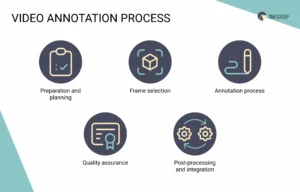
1. Preparation and planning
Effective preparation and planning are the bases for a successful video data annotation project. This initial step involves defining the project objectives, determining the annotation scope, and establishing guidelines.
Firstly, it’s essential to outline the annotation project’s goals clearly. A clear understanding of the intended outcomes guides subsequent decisions and ensures alignment with overarching objectives.
Next, defining the annotation scope involves identifying the types of annotations needed, such as bounding boxes, key points, semantic segmentation, etc. Moreover, considering factors like scenes’ complexity, objects’ diversity, and variability in lighting conditions aid in developing a comprehensive annotation strategy.
Annotation guidelines are vital in maintaining consistency and accuracy throughout the annotation process. These guidelines should contain annotation instructions, annotation tools, and protocols for resolving ambiguous scenarios. By investing time in thorough preparation and planning, annotation teams can streamline workflows and decrease potential challenges.
2. Frame selection
In video data annotation, frame selection involves strategically choosing frames that best represent the content and context of the entire video sequence. Given the vast number of video frames, selecting keyframes for annotation optimizes efficiency without compromising annotation quality.
Critical considerations for frame selection include:
- Diversity: Ensure that selected frames include a diverse range of scenes, objects, and actions in the video.
- Information density: Prioritize frames containing critical visual information, such as instances of object occlusion, motion blur, or complex interactions.
- Temporal continuity: Maintain temporal coherence by selecting frames representing smooth transitions between consecutive frames, facilitating seamless annotation.
Employing automated techniques, such as keyframe extraction algorithms or motion-based frame selection, can accelerate the frame selection process while preserving the representativeness of the annotated dataset.
3. Annotation process
The annotation process carefully labels objects, actions, or attributes of interest within the selected frames. Annotation tasks may vary depending on the project requirements, ranging from simple bounding box annotations to more complicated pixel-level segmentation.
To ensure accuracy and consistency, annotation teams should adhere to established guidelines and use intuitive annotation tools with features like zooming pan and object tracking. Additionally, implementing quality control mechanisms (inter-annotator agreement checks and regular feedback sessions) fosters collaboration and enhances annotation precision.
Furthermore, promoting a conducive annotation environment, characterized by clear communication channels and adequate training resources, empowers video annotators to perform their tasks efficiently.
4. Quality assurance
In fact, quality assurance (QA) is a critical checkpoint in the video data annotation pipeline. It aims to identify and rectify any distinctions or inaccuracies in the annotated data. Through systematic validation procedures and error analysis, QA mechanisms ensure the integrity and reliability of the annotated dataset.
There are critical aspects of quality assurance in video data annotation:
- Anomaly detection: Employ automated anomaly detection algorithms to flag inconsistencies, such as misaligned annotations or outliers in annotation attributes.
- Sampling strategies: Implement random sampling techniques to select subsets of annotated frames for manual review, enabling thorough error detection and correction.
- Performance metrics: Use quantitative metrics, such as precision, recall, and F1-score (combines precision and recall scores), to evaluate annotation accuracy and assess annotator proficiency.
By integrating robust quality assurance protocols into the annotation workflow, companies can instill confidence in the annotated dataset and ultimately enhance the performance of downstream machine learning models.
5. Post-processing and integration
The final step in the video data annotation process involves post-processing annotated data and seamlessly integrating it into downstream applications or machine learning pipelines. This phase has tasks such as data formatting, metadata enrichment, and integration with annotation management systems.
During post-processing, ensure compatibility with standard data interchange formats, such as JSON or XML, to facilitate interoperability with various machine learning frameworks and applications. Also, enriching annotated data with contextual metadata (timestamps, spatial coordinates, or object attributes) enhances the richness and utility of the dataset for subsequent analysis tasks.
Furthermore, integrating annotated data into annotation management systems or version control repositories enables efficient data storage, retrieval, and version tracking, ensuring traceability and reproducibility throughout the annotation lifecycle.
In general, mastering the video data annotation process requires a systematic approach. Employing best practices and using advanced annotation tools and techniques, organizations can generate high-quality annotated datasets. These datasets are invaluable assets for training robust machine learning models and advancing computer vision applications across diverse domains.
Essential video data annotation techniques for success
Our experts have prepared some top practices in video annotation. By following these practices, you can enhance the quality of annotated datasets and the effectiveness of downstream applications. Let’s analyze these techniques.
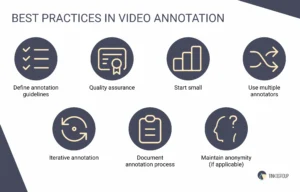
Define annotation guidelines
Establish clear guidelines for annotators to ensure consistency in video labeling. Guidelines should include definitions of categories, annotation methodology, and examples of different scenarios.
Quality assurance
Implement quality control measures to maintain annotation accuracy. This may involve random checks of annotations, inter-annotator agreement tests, and regular feedback sessions with video annotators.
Start small
Begin with a small dataset and gradually scale up as you gain confidence in the annotation process. This allows you to refine your annotation guidelines and address issues early on.
Use multiple annotators
Employ multiple annotators to annotate each video segment independently. This helps to reduce individual biases and errors and allows for the calculation of inter-annotator agreement to measure annotation consistency.
Iterative annotation
Iterate the annotation process based on feedback and insights from initial annotations. This may involve refining guidelines, retraining annotators, or revising annotations based on new information.
Document annotation process
Keep detailed records of the video annotation process, including annotation guidelines, annotator training materials, and any revisions made during the annotation process. This documentation aids in reproducibility and facilitates future analyses.
Maintain anonymity (if applicable)
If the videos contain sensitive information or individuals, ensure that annotators do not have access to identifying information and adhere to strict privacy protocols.
Popular video annotation machine learning models
AI video annotation is crucial in machine learning, especially in computer vision applications that require understanding and analyzing video content. Here are some popular machine-learning models and techniques used for video annotation:
Convolutional neural networks (CNNs)
They are widely used for AI video annotation tasks. CNNs can be applied to frame-level analysis, where each frame of the video is treated as an individual image. These CNN architectures like ResNet, VGG, and Inception have been adapted for video annotation tasks.
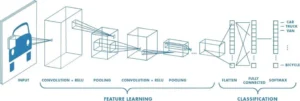
Recurrent neural networks (RNNs)
In fact, RNNs, particularly Long Short-Term Memory (LSTM) networks, are helpful for sequential data processing. In video annotation, they can be used to model temporal dependencies between frames. RNNs can capture the motion and temporal information in videos, making them suitable for action recognition and video captioning tasks.
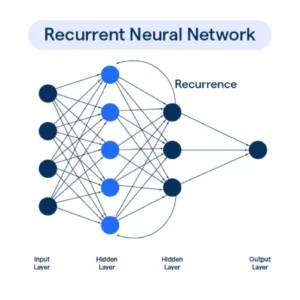
You Only Look Once (YOLO)
This real-time object detection system can be used for video annotation by processing each video frame and detecting objects within it. This enables tasks such as real-time object detection, tracking, and annotation. YOLO’s efficiency allows it to process videos at high frame rates, making it suitable for applications like administration, autonomous vehicles, and video analysis in real time.
Attention mechanisms
First, these mechanisms are used to selectively focus on relevant parts of the video sequence while performing annotation tasks. They have been integrated into various architectures like CNNs and RNNs to improve performance in tasks such as video captioning and fine-grained action recognition.
Transformer models
These models, known for their success in natural language processing (NLP) tasks, have also been applied to video annotation tasks. By treating each frame or segment of frames as tokens, transformer architectures can be adapted to encode temporal relationships and perform annotation tasks.
Two-stream networks
In general, these networks consist of two separate streams, one for spatial information (RGB frames) and one for motion information (optical flow or stacked optical flow). By combining both streams, these models can capture appearance and motion features, improving performance in tasks such as action recognition.
Reinforcement learning
These learning techniques have been used for video annotation tasks. The model learns to generate annotations iteratively by interacting with the video data and receiving feedback on the quality of generated annotations. Reinforcement learning has been applied in tasks like video summarization and active learning for video annotation.
So, these are some prominent machine learning models and techniques used for video annotation. The choice of model depends on the annotation task’s specific requirements, including the video content’s complexity, available computational resources, and the desired level of accuracy.
Common challenges of video annotations
Nothing is perfect, so video annotation has challenges, ranging from technical complexities to subjective performance. Here are some of the significant challenges associated with video annotation:
- Temporal complexity. Unlike static images, videos have a temporal dimension, making annotation more complex. Annotators must precisely mark when an object appears, moves, or disappears within the video frame. This requires careful attention to detail and may involve annotating multiple frames to capture the complete temporal context accurately.
- Scalability. Video data is often large-scale, posing scalability challenges for annotation tasks. Manually annotating large volumes of video data can take time and effort. Developing efficient annotation tools and strategies to handle large-scale video datasets is essential for scalability.
- Subjectivity and ambiguity. Video data annotation often involves subjective interpretation, especially when labeling complex actions or events. Annotators may interpret the same video content differently, leading to inconsistent annotation. Establishing clear annotation guidelines and providing adequate training to annotators can help reduce subjectivity and ensure annotation consistency.
- Labeling granularity. Determining the appropriate level of granularity for annotations is crucial but challenging. Depending on the specific application, annotators must decide whether to label individual objects, object parts, actions, or scenes. Balancing granularity with annotation efficiency and relevance to the task is an important task that requires domain expertise and careful consideration.
- Labeling diversity. Videos often contain diverse content, including different object categories, appearances, and environmental conditions. Annotators need to account for this diversity when creating annotation labels to ensure the robustness and generalization of machine learning models. Handling diverse video labeling requirements while maintaining annotation quality is a significant challenge.
- Labeling occluded or partially visible objects. For example, video objects may be occluded, partially visible, or exhibit varying degrees of deformation, making accurate annotation difficult. Annotators must determine how to label such objects and account for uncertainties in annotation boundaries. Developing annotation techniques robust to occlusion and partial visibility is essential for accurate video analysis.
- Long-term dependencies. Videos often contain long-term dependencies and complex temporal dynamics that require capturing interactions and context over extended time spans. Annotators must annotate these dependencies accurately to enable practical video understanding and prediction. However, annotating long-term dependencies introduces additional complexity and requires sophisticated annotation techniques.
In general, addressing these challenges requires a combination of advanced annotation tools, clear guidelines, quality control measures, and domain expertise. Despite these challenges, accurate video annotation is essential for advancing research and applications.
Our expert annotation services await you
At Tinkogroup, our commitment to precision and innovation in data processing has led us to enhance our expertise in video annotation services. Our journey in this domain is marked by continuous learning, technological advancements, and a steadfast dedication to delivering exceptional client results.
Moreover, we understand the importance of flexibility and customization in meeting diverse client needs. Our collaborative approach facilitates open communication and iterative refinement, empowering clients to shape the annotation process actively according to their evolving objectives.
Central to our approach is a combination of advanced tools and human expertise. While automated annotation algorithms offer efficiency and scalability, we understand the irreplaceable value of human judgment in tasks requiring nuanced interpretation. Our skilled annotators diligently annotate each frame, ensuring accuracy, consistency, and relevance to the project objectives. Through this hybrid approach, we strike a balance between speed and precision, delivering results that exceed expectations.
Our specialists use various data annotation software, including CVAT, LabelBox, Imglab, LabelMe, Sloth, and more. For example, let’s check the transformative capabilities of the Computer Vision Annotation Tool (CVAT) that elevate our video annotation services.
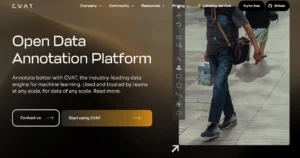
At Tinkogroup, our commitment to precision and efficiency. Its user-friendly interface enables our team to annotate videos seamlessly, covering tasks like object detection, classification, and segmentation. CVAT’s collaborative features encourage smooth communication among our annotation team, ensuring accuracy and consistency.
Moreover, CVAT’s integration with AI algorithms enhances our annotation speed and accuracy, making our services cost-effective and scalable. We can customize CVAT to meet specific project requirements, ensuring alignment with our client’s objectives.
As we continue to employ CVAT’s capabilities, we remain committed to delivering high-quality video annotation services that drive insights and innovation for our clients.
Final thoughts
Video annotation ensures success in AI development by carefully planning, selecting keyframes, accurately video labeling, checking for errors, and seamlessly integrating data. Ultimately, this guide empowers everyone—from businesses to researchers—to make the most of visual data.
At Tinkogroup, we are here to offer you expert solutions and support every step of the way. Want to advance your AI projects with precision and efficiency? Contact us today to learn more about our progressive data annotation services and how we can tailor them to meet your needs. Let’s turn your vision into reality together. Contact us now to get started!
FAQ
What is a video annotation?
Video annotation refers to adding metadata or labels to various elements within a video, such as objects, actions, or events. This metadata enhances understanding and analysis, facilitating tasks like machine learning (ML) training, content indexing, and video search.
What is video labeling?
Video labeling involves identifying and categorizing different components or actions within a video. This process assigns descriptive tags or labels to objects, people, movements, or events, enabling efficient data analysis, classification, and interpretation.
How to annotate video data?
Annotating video data involves several steps: preparation, selection (e.g., bounding boxes, keypoints, semantic segmentation), annotation, validation, and integration.
How to annotate video?
Annotating video requires specific tools and methodologies: software tools, annotation types (bounding boxes, polygons, or temporal segments), manual annotation, semi-automated techniques (object tracking or motion estimation), and quality assurance.

